Abstract
Background: Dental traumas are common among children and adolescents in many societies posing health and social problems. The aim of this study was to conduct a systematic review and meta-analysis on prevalence, etiology, types, and other epidemiologic aspects of dental trauma in children and adolescents (0-18 years old).
Methods: In this systematic meta-analytical review, data were collected searching for key words including traumatic dental injuries, dental trauma, dental injury, dental trauma, tooth injuries, tooth trauma, traumatized teeth, dentoalveolar trauma, oral trauma, epidemiology, etiology, prevalence, incidence, occurrence, child*, and adolescence in the following databases: Scopus, CINAHL, Science Direct, PubMed and Google scholar.
Results: From the total of 3197 articles, 44 completely relevant papers were included in the study. The prevalence of dental trauma was variable based on geographical area and was estimated 17.5% in the population, with higher prevalence in boys. Falling was the major cause for dental trauma, and the most frequent location was home. The most frequent type of trauma was enamel fracture.
Conclusion: A relatively high prevalence was detected for dental trauma, which calls for effective planning and intervention to prevent the occurrence in children and adolescents. These may include special care for children, eliminating fall-prone areas, installing safety measures at homes, using protective appliances in sports, education, and raising the knowledge and availability of services to address enamel fracture. Region-specific criteria should be taken into account in programs and interventions.
Keywords: Dental Trauma, Prevalence, Etiology, Type, Children and Adolescents, Systematic Review, Meta-analysis
Introduction
Traumatic injuries not only pose a health risk worldwide, but are also regarded among serious social problems (1). One important category is dental trauma (2), accounting for a major part of health problems in children and adolescents (3-6). Studies conducted in different countries report various prevalence rates for traumatic dental injuries among children and adolescents (7-10). Dental trauma occurs in children mainly because of their weak balance and just having learnt to walk (11).
Demographic evaluations indicate a higher prevalence for trauma in males compared to females (12-14). Falling, fight, sports, accidents, and hitting items or people are among common etiologic factors (15-18). Home setting, school and street are places with the highest frequency of dental traumatic injuries (19,20), which most importantly include enamel fracture and enamel and dentin fracture without pulp exposure (21-24).
According to the heterogeneity among the individual study results and the importance of preventing dental trauma, it is of importance to accurately determine the prevalence of dental trauma using appropriate research methodology. Also identifying the influencing factors is essential for better planning, decision-making and intervention.
Therefore, the present study aimed to conduct a systematic review and meta-analysis on the prevalence of dental trauma among children and adolescents in different countries and other related variables.
Methods
This study was a systematic and meta-analytical review. The required date were collected searching for key words including traumatic dental injuries, dental trauma, dental injury, dental trauma, tooth injuries, tooth trauma, traumatized teeth, dentoalveolar trauma, oral trauma, epidemiology, etiology, prevalence, incidence, occurrence, child*, and adolescence in Scopus, CINAHL, Science Direct, PubMed, Google scholar. Manual journal searching and an extensive hand search of the Gray Literature were also conducted. Articles from the reference list of the studies which were found to be relevant were also considered. Article publication time limit was set 1995 onward.
Articles in English and Persian that reported dental trauma (injury to the teeth and/or periodontium, and nearby soft tissues) and those studies (2) that were conducted on children and adolescents with age range of 0-18 years and cross-sectional studies were also included. Exclusion criteria were as follows: studies on trauma from sport activities, studies on trauma from medical interventions such as endoscopy, studies on individuals with medical or special conditions, conference presentations, case reports and interventional studies (such as randomized controlled trials). Two reviewers evaluated the articles according to the checklist of strengthening the Reporting of Observational Studies in Epidemiology (STROBE) (Appendex. 1) and controversies were referred to a third party. First, articles with non-relevant titles to the subject of this review were excluded. Then, the abstracts and the full texts of the articles were reviewed respectively to exclude those articles that matched the exclusion criteria of the study, or had a weak relevance to the subject of the study. Computer software for reference management (Endnote X5) was used for organizing and assessing the titles and abstracts as well as recognizing the repetitive items.
The searches returned 3197 articles, but those articles that were non-relevant, and repetitive between databases, with weak relevance to the study or matched the exclusion criteria were excluded; finally, 44 relevant articles were selected (Fig. 1). These articles were fully read, and the required data for the systematic review were extracted into the extraction table designed for the purpose of the study in spreadsheet computer software (Excel, Microsoft Office; Microsoft, US). SPSS 17 was used to analyze some of the quantitative data.
Fig. 1 .
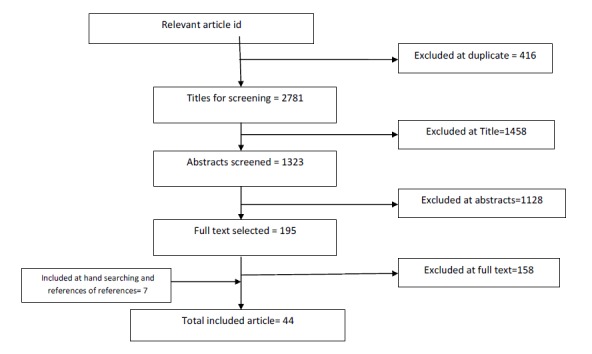
Literature review and retrieval flow diagram
Fig. 2 .
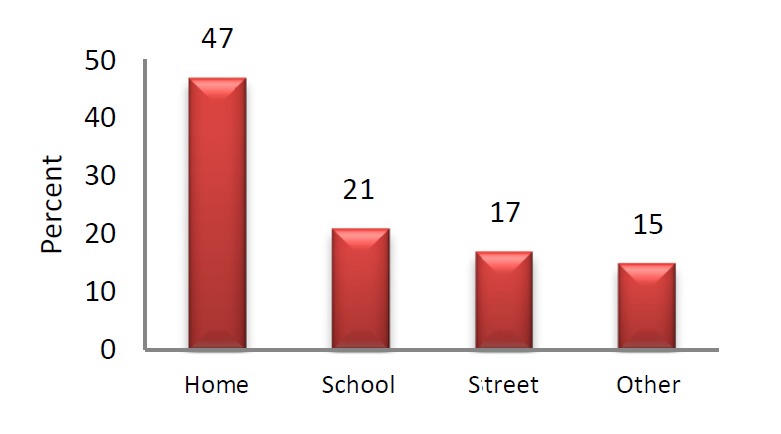
Trauma place of occurrence
To determine the overall prevalence of dental traumatic injuries and perform the meta-analysis, computer software (CMA-Comprehensive Meta-Analysis; Englewood, NJ, USA) was employed. The results were reported using forest plots, in which the size of each square indicates the sample size and the lines drawn on each side of the square indicate the confidence interval (CI) of approximately 95% for dental trauma.
The overall prevalence of dental traumatic injuries was estimated using the random model. Either all or some of the variables were treated as if they were random. Random model was in contrast with the fixed model that demonstrates the observed quantities with respect to the explanatory variables which are treated as if the variable were not random.
Results
From a total of 3197 relevant articles, 44 completely relevant articles were included in the study. Most studies were conducted in Brazil (16 articles), and the oldest was conducted in Jordan (1995); most of the studies were done in dental clinics, and only two out of the 44 (4%) studies were conducted in IRAN. The overall number of participants was 69502 children and adolescents aged 0-18 years (mean, 1579 each study). The mean±SD prevalence of dental trauma was 10.2% ± 4.70 among boys and 6.5% ± 3.40 girls, which was statistically significant (p< 0.001).
The mean of falling was the most frequent cause of dental trauma. The most important etiological factors of traumatic dental injuries are shown in Fig. 1.
Places with the highest frequency of traumatic dental injuries are demonstrated in Table 1.
Table 1 . Extraction table for Prevalence, etiology, and types of dental trauma in children and adolescents .
| Au-Cu-Ye | Sample | prevalence | Gender | Etiology | place | Type/teeth affected |
| Schuch et al [25], Brazil,2012 | 1210-children aged 8–12 | 12.6% | M (6.8), F(5.8) |
Fall (35), Assault (40), Accident (8), Sport (10), other (7) |
Home (55), School (18) Street (15).other (12) |
Enamel fracture (10.6), dentin Fracture (3.2), other (.5) |
| Martins et al [26], Brazil,2012 | 590 children aged 7-14 years | 12.7% | M (7.9), F(4.8) | - | - | - |
| Piovesan et al, Brazil,2012 |
441 children-of 12- to 59-month-old |
31.7% | M(18.6), F(13.1) | - | - | fracture of enamel only (86.91), fracture of enamel and dentin(4.20),fracture involving pulp(3.27),other (5.69) |
| Dame´-Teixeira et al[27]. Brazil,2012 | 1528-12-year-old | 34.8% | - | - | - | Enamel fracture only(71.16),Enamel-dentin fracture (25.84), other (2.99) |
| Teixeira et al [28], Brazil,2012 |
1528-12-year-old Schoolchildren. |
34.79% |
M(40.8) F(28.6 ) |
Not remember the cause (53.64%), Falls (15.46%), sports (11.08%), collision against objects or people (10.60%), violence (.7%), traffic accidents (.5%), other causes (7.98%) | Home (22.32%), school (8.52%) elsewhere (15.50%) | |
| Piovesan et al [29], Brazil, 2011 |
792 12-yearold schoolchildren, |
9.7% | Crown fracture of enamel only ( 94.5), Crown fracture of enamel and dentin ( 4.4), Crown fracture involving pulp ( 1.1) | |||
| Jorge et al [30], Brazil, 2011 | 891Adolescents from schools. | 24.7% |
M(27.6) F(22.8) |
Unknown (33.2), Falls (17.7), Playing(12.7), Collision (10), Violent incident (7.3), Sports(6.4), Use of teeth for functions other than eating (5.9), Chewing (5), Traffic accidents (1.8), | ||
| Aldrigui, et al [31], Brazil, 2011 |
260 children aged from 2 to 5 years |
33.5% | ||||
| Norton and O’Connell [32], Ireland,2012 |
839- children between 9 and 84 months |
25.6% |
M(26.7) F(24.6) |
Most injuries occurred within and around the home, 46.9% and 35.7%. |
enamel fracture (39.4%), discoloration of the crown (20.2%) |
|
| Bendoand et al [33], Brazil,2010 |
1612 children aged 11 to 14 |
17.1% |
M (19.9%) F (15%) |
Falls (43.6), Sports (20.4), Unknown (25.5), Others (10.5) | Home (41.8), School (14.2), Street (10.5), Unknown (24.4), Others (9.1) | Enamel fracture (63.6), Enamel-dentin fracture (15.3), Complicated crown fracture (1.8), Lateral luxation (0.4), Avulsion(0.7), Restoration (23.3) |
| Dıaz et al [34], Chile,2010 | 1719 from 1 to 15 years of age, | 37.9% | ||||
| Altun et al, Turkey[35],2009 | 4956 children aged 6–12 years | 9.5% |
M (5.4%) F (4.1%) |
Fall (40.3), Impact with a hard object (30.5), Bicycle/tricycle accident (25.4), Other 18 (3.8) | Enamel fractures (44.6), Enamel/dentin fracture (19.0), Intrusive luxation (13.4), Lateral luxation (7.3), Subluxation( 6.1), Enamel/dentin/pulp fracture (5.5), Crown discoloration(5.2), other (7.1) | |
| Noori and Al-Obaidi [36], Iraq, 2009 | 4015, 6- to 13-year-old children | 6.1% |
M (3.7%) F (2.4%) |
Falls (60.9), Playing (21.4), Impact with a hard object (9.1), other (8.6) | At home (69.9), school (17.7), on street (18.9), Unknown (2.5) | Enamel fracture (36.6%), enamel-dentine fracture (35.4%), and concussion (11.5%). Other (16.5) |
| Avsar and Topaloglu [37], Turkey,2009 | 563- children 0–3 years | 17.4% |
M (10.3%) F (7.1%) |
Falls (73.5), Striking objects (14.2), Traffic accident (1), Child abuse (2), Unknown (9.2) | ||
| Naidoo and et al[38], South Africa,2009 | 1665 children aged 11–13 years | 6.4% |
M (4.2%) F (2.2%) |
Falls (43.4%), Sport (13.2%), collision With objects (9.4%), Unknown (8.5%) |
Homes (46.3%), schools (35.8%), on a street (5.7%) | Enamel fracture (69.1%), enamel and dentine (22.8%), enamel, dentine and pulp (5.7%) |
| Jorge et al [30], Brazil,2009 |
519 infants and toddlers between 1 and 3 years of age |
41.6% | Falls (29.8%), collisions (6.8%) |
Home (32%), street (1.7%), day care centers (0.8%) |
Enamel fractures (37.2%), enamel–dentin fractures (5.7%), | |
| Fakhruddin et al [39], Canada, 2008 | 242212- to 14-year-old Ontario schoolchildren | 11.4% | Falls (24.8%),Sport (23.7%),collision with objects (10%), violence (5.9%), other (35.6) | School (24.4), Home (21.1), street (7.4) | ||
| Pattussi et al, Brazil [40],2006 | 1302 14- to 15-year-old adolescents | 16% |
M (9.6%) F (6.4%) |
Playing (48.1), Sports(13.3), Teeth misuse (9.0), Violence (5.7), Other causes (14.8), Don’t know (9.0) | Home (44.3), Street/walkway (26.7), School (10.0), Other places (10.0), Don’t know (9.0) | |
| Locker[41], Canada,2005 | 3010 grade 8 children | 18.5% | ||||
| Traebert et al [42], Brazil,2003 |
307, 12-year-old school Children |
18.9% |
M (11.7%) F (7.2%) |
Fall (47.9), Collision (37.5), Traffic accident (2.1), Eating (2.1), Unknown (10.4) | Home (60.4), School (18.4), street (18.6), Swimming pool (2.4) | |
| Nicolau et al [43], UK,2001 | 652 , 13-year-old adolescents | 20.4% |
M (13.9%) F (6.5%) |
Fall (24.1), Collisions ( 15.0), Traffic accidents (10.5), Misuse of teeth (6.0), Sports (2.3), Violence (1.5), Unknown (40.6) | ||
| Cortes et al [44], Brazil,2001 |
3702-schoolchildren aged 9–14 years |
12% |
M (7.2%) F (4.8%) |
|||
| Vanderas and Papagiannoulis [4], Greece, 1999 | 199 children aged 8 to 10 years | 16.6% |
M (11.5%) F (5.1%) |
Enamel fractures (75.8) Infractions (24.2) |
||
| Marcenes and et al, Syria[45],1999 |
1087 children aged 9 to 12 years, |
8% |
M (5.3%) F (2.7%) |
Fall (9.1), Collision (32), Traffic accidents (24.1), Violence (42.5), Other (3.4), Missing information (4.6) | ||
| Chen et al [46], Taiwan, 1999 | 1200 second grade students | 16.5% |
M (10.2%) F (6.3%) |
Collision (65.3), Fall (26.9),Violence (2.6), Sport (3.6), Other (1.6), | Home (63.7), School (23.8), other (12.4) | |
| Petti et al [47], Italy,1997 | 938, 6- to I 1-year-old children | 21.3% | Indoor play (31.5), Outdoor play (31), Sport (9), Fall (8), Traffic accident (1.5), Chewing (1),Unknown (18) | |||
| Huang et al [17], Taiwan, 2009 | 6312 15- to 18-year-old senior high school | 19.9% | M (12.4%) F (7.5%) | Sports(30.8), Eating (20.5), Falls (19.4), Traffic Accidents (10.2), Collisions (7.1), other (12) | Home (29.1%), school (23.7%), street (11.1%) | |
| Kovács et al [48], Romania., 2012 |
4638 -children and adolescents aged between 1 and 18 years |
24.8% | M (14.6%) F (10.2%) | Fall (42.5), Sports(23.5), accidents (9.5), violence (7.5),Collision (5.5), Other (6.5),Unknown(4.7) | Uncomplicated coronal fracture (26.1), Enamel fracture (12.5), Lateral luxation (11.2), Contusion (7.7 ), other (42.5) | |
| Govindarajan et al [49], India, 2012 | 3200 school children in the age 3-13 years | 10.13 | M (6.03%) F (4.1%) | Fall (41.9), Sports(19.1), accidents (8.64), violence (5.8), Collision (.3), Unknown(24.07) | ||
| Dua and Sharma [50], India, 2012 | 880 children in the age 7-12 years | 14.5% | Enamel fracture (50%), crown fracture without pulpal involvement (20.3), crown fracture with pulpal involvement (13.2), avulsion (4.6), fracture unspecified(11.9) | |||
| Abdulaziz and et al[51], 2010, Kuwait | 500 preschool children(2–6 years) | 11.2% | Fall (94.6%), | Home (87.5%), street (7.1%), school (5.4%). | Enamel fractures (29.4), enamel- dentin fractures (26.5), crown fractures (14.7), | |
| Malikaew et al [52], Thailand, 2006 | 2,725 of 11-13 year old Thai children. | 35.0% | M (22.1%) F (12.9%) | Fall (24.8%), Collision(21.1), Traffic accident(1), Misuse of teeth(18.7), Unknown(21.7) , other (12.7) | Homes (31.7), schools (28.0), street (4.7), swimming pool (1.2), other (10.7) | Enamel fracture (83), enamel- dentin fractures (4.8) |
| -Hamdan and Rock[53], Jordan, 1995 | 459 schoolchildren aged 10-12 years | 17.3 | M (10.4%) F (6.9%) | |||
| Vejdani. And Mohammad Alizadeh, Iran [54]; 2006 |
700 fifth and sixth grade schoolchildren |
10.3 | M (5.4%) F (4.9%) | Falls (37.5), Collision (22.2), Traffic accident (4.2), Sports (19.4), other (17.7), | Enamel fracture(76.4), Enamel and dentine fracture(19.4)، Enamel, dentin and exposure of the pulp (4.2) | |
| Vejdani et al [55], Iran; 2011 |
1042 fifth and sixth grade schoolchildren |
15.2 | M (9.6%) F (5.6%) | Enamel fracture (8.3) , Enamel and dentine fracture (16.9)، Enamel, dentin and exposure of the pulp (2.1) | ||
| Sgan-Cohen et al [56],Israel, 2005 |
1195 fifth and sixth grade schoolchildren |
29.6% | Falls (30.3), violence (30.3), Sports (27.3) | Homes (31.4), schools (32.2), street/ outside (36.4) | ||
| Nicolau et al [43], Brazil, 2001 | 652 ,13-year-old adolescents | 20.4% | M (13.7%) F (6.7%) |
Falls (24.1) collisions (15), traffic accidents (10.5), misuse of the teeth (6), sports (2.3) violence (1.5). |
||
| Rajab [57], Jordan,2003 | 2751 children | 14.2% | M (9.2%) F (5%) | Falls (49.9) collisions (30), sports (8.7) violence (7.2). traffic accidents (3) | Homes (63.17), schools (25.5), street (11.25) | Enamel and dentine fracture (43.8), Enamel, dentin and exposure of the pulp (37.5), Enamel fracture (14.6) |
| Soriano et al [58], Brazil, 2007 | 1046 boys and girls aged 12 | 10.5% | Falls (27.3) collisions (18.2), sports (8.2) violence (6.4). traffic accidents (2.7), Non-specified accidents (22.7) other (14.5) | Homes (25.5), schools (13.6), street (23.6), Do not remember (20.9), other(16.4) | Enamel fracture(47.3), Enamel and dentin fracture without pulp exposure (34.5), Crown fracture without pulp exposure (10), other(8.2) | |
| Sgan-Cohen et al [59], Israel, 2008 |
453 5th and 6th grade schoolchildren |
33.8% | Falls (29.1), sports (16.4) violence (20), playing (20) | |||
| David et al [60], South India,2009 | 838 12-year-old school children | 6.1% | ||||
| Wendt et al [61], Brazil, 2010 | 571 preschool children | 36.6% | M (19.7%) F (16.9%) | |||
| Thelen and Ba°rdsen, Albania[62], 2010 | 2789, adolescents aged 16–18 years | 9.9% | M (5.8%) F (4.1%) | Collision (27.5), Falls (13.4), sports (14.1) violence (4.0), Traffic accidents ( 4.7), Do not remember( 10.5), other(25.8) | ||
| Livny et al [63], Israel, 2010 | 804 sixth grade Children of ages 11 and 12 years. | 17.7% | M (11.1%) F (6.6%) |
The mean of enamel fracture had the highest frequency (55%) among the types of dental trauma in children and adolescents (Fig. 3).
Fig. 3 .
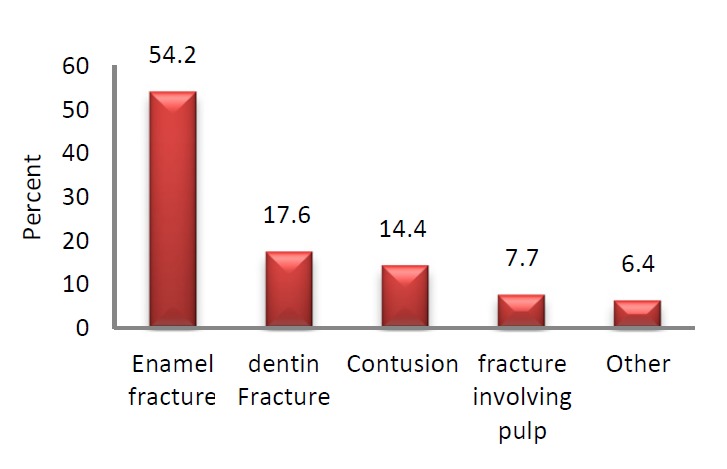
Type of dental trauma
To perform the meta-analysis, the heterogeneity index was determined within the articles using the heterogeneity I2 test. After confirmation of heterogeneity of the studies, the best estimation of the prevalence of trauma was determined based on the random effect model (Fig. 4).
Fig. 4 .
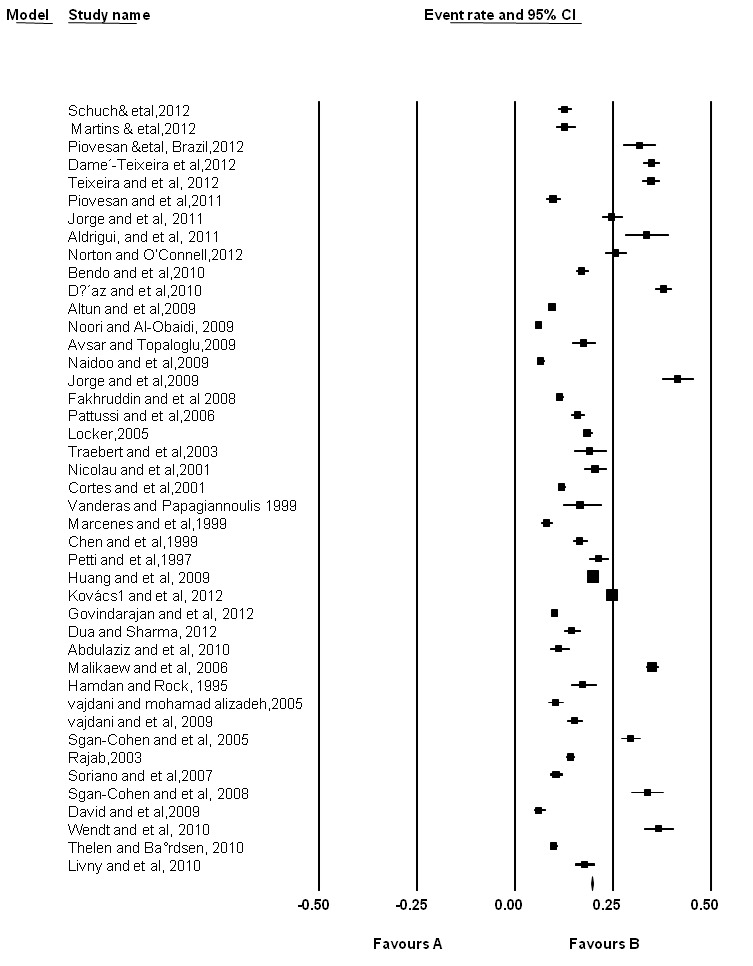
The prevalence of dental trauma in children and adolescents based on the random effect model.
The prevalence of dental trauma in children and adolescents based on the random effect was determined to be 17.5% (95% CI: 14.6%-20.4 %); 95% CI for the prevalence was drawn for each study in the horizontal line format (Q= 3631.17, df= 43, p<0.001).
The frequency distribution for dental trauma based on the location variable (continent) is shown in Figs. 5-7.
Fig. 5 .
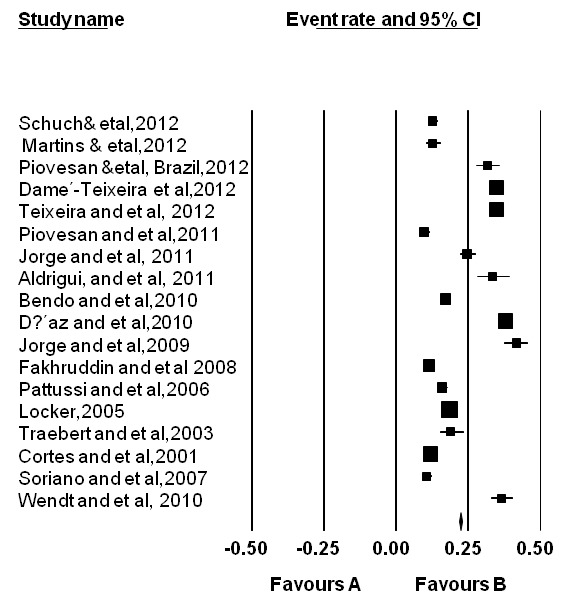
The prevalence of dental trauma in children and adolescents in the continent of America was estimated based on the random effect of 21.2% (95% CI:16.6%-26.7%); 95% CI was drawn for each prevalence in the horizontal line format (I2= 98.7).
Fig. 7 .
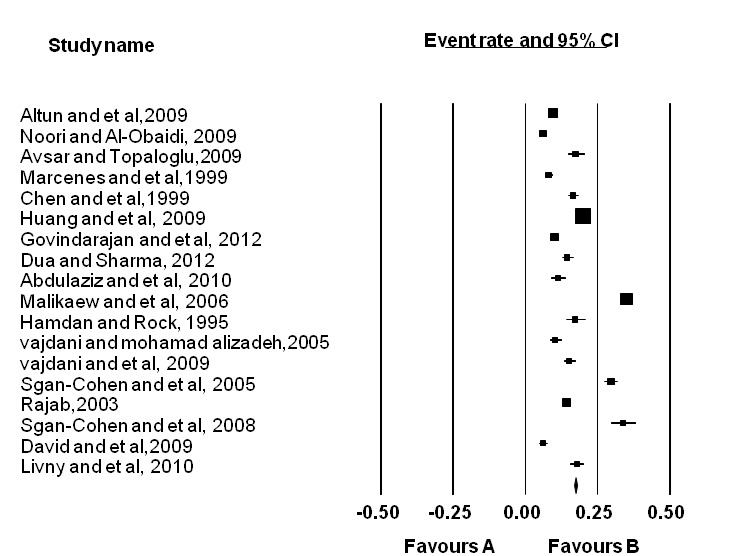
The prevalence of dental trauma in children and adolescents in Asia was estimated based on the random effect of 14.7% (95% CI: 11.3%-19.0 %); 95% CI was drawn for each prevalence in the horizontal line format (I2 = 98.4).
Fig. 6 .
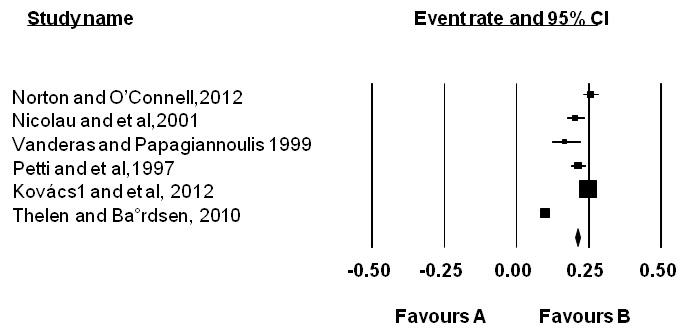
The prevalence of dental trauma in children and adolescents in Europe was estimated based on the random effect of 19.1% (95% CI:13.7%-24.1%); 95% CI was drawn for each prevalence in the horizontal line format (I2= 97.9).
To assess the publication bias, funnel plot was used (Fig. 8). The results of funnel plot revealed that there was publication bias among studies. The shape of funnel plots was not symmetrical.
Fig. 8 .

Funnel plot of standard error by event rate
Discussion
Dental trauma is a major health problem in many societies (26,29,30), with higher prevalence rates among children and adolescents (25,26,29,48,64). The present study revealed the prevalence of dental trauma in children and adolescents (under 18 years of age) to be 17.5%, but with variances among different geographic regions.
In the present study, the prevalence of dental traumas for all subjects was determined to be 17.5%, which necessitates efficient planning and intervention to prevent their incidence. Moreover, considering the negative influence of dental traumas on individuals’ quality of life (39,65), psychological and social problems (66,67), and direct and indirect costs of treatment (68), developing effective interventional strategies to deal with this issue is of prime importance. The difference in the prevalence of dental trauma among the studied geographic regions might be a reflection of their different cultural, sanitary, and economic conditions, type of activities and professions practiced, and ecological characteristics like the fluoride concentration of drinking tap water. For instance, the prevalence of dental trauma was found to be higher in the continent of America compared to Asia or Europe, and this could be the result of sports activities of youth, as most studies in the region pertained to Brazil. Furthermore, the fluoride concentration of water in regions with mild and humid weather condition is usually low (69), resulting in lower fluoride content in teeth which can render teeth more prone to dental trauma. This notion highlights the importance of local and regional considerations during planning and interventions by policy makers.
The prevalence of dental trauma was higher in boys compared to girls (10.2 ± 4.7 vs. 6.5 ± 3.4). Previous studies also agree on the higher prevalence of dental trauma in boys than girls (27,51,70-72), which might be due to boys performing more activities like sports, bicycle riding, fighting, working, etc. compared to girls (73).
In the present study, the most important cause for dental trauma was falling, which is in agreement with previous literature (74-78). This can be explained by the imbalance of the newly walking children leading to falling accidents. Thus, children should be cared more prudently, reinforced by measures to eliminate the risk of falling. The other important cause of dental trauma in this study was sports, which is in line with previous research (79,80). Ensuring the existence of sound safety measures in sports venues accompanied by the use of protective athletic appliances such as mouth guards, and educating children and adolescents who engage in sports activities are among suggestions that can be effective in reducing the incidence of dental trauma in this age range (81,82). Fights and violence were also among the causes of dental trauma in children and adolescents in the present study, which is indicative of the behavioral characteristics of this age range, with dominant, violent, emotional, and illogical traits. In this regard, special attention should be given to social education at home and school, fostering a culture of self-control and social respect towards others.
The findings of this study revealed that dental traumatic accidents occurred most frequently at home, and this is in line with many previous studies (83-85). This is explainable by the fact that children and adolescents spend a significant part of their time at home; and therefore, special safety measures should be considered at houses in which families live with their children.
Based on the analysis of the study data, enamel fracture was the most frequent type of dental traumatic accidents, confirming the findings of other studies (34,42,56,86). Therefore, dentists and other health-care professionals as well as lay people should have adequate knowledge regarding the management of dental traumatic events (87-90).
The analyses performed in the present study were limited by age under 18 years. Thus, it is suggested to include adults in future studies. The study was also limited by the fact that it only included articles in English and Persian and only included studies conducted since 1995.
Conclusion
The results of this study indicated a significant prevalence for dental traumatic accidents among children and adolescents, which necessitates efficient planning and interventions in order to prevent their incidence. Planning for reducing the risk of falling in children would be of utmost importance. Safety measures would be most effective when implemented at home where dental traumatic accidents occur most frequently.
Cite this article as: Azami-Aghdash S, Ebadifard Azar F, Pournaghi Azar F, Rezapour A, Moradi-Joo M, Moosavi A, Ghertasi Oskouei S. Prevalence, etiology, and types of dental trauma in children and adolescents: systematic review and meta-analysis. Med J Islam Repub Iran 2015 (10 July). Vol. 29:234.
References
- 1.Leung YY, Cheung LK. Can coronectomy of wisdom teeth reduce the incidence of inferior dental nerve injury? Ann R Australas Coll Dent Surg. 2008;19:50–1. [PubMed] [Google Scholar]
- 2.Vanderas AP, Papagiannoulis L. Urinary catecholamine levels and incidence of dentofacial injuries in children: a 2-year prospective study. Endod Dent Traumatol. 2000;16(5):222–8. doi: 10.1034/j.1600-9657.2000.016005222.x. [DOI] [PubMed] [Google Scholar]
- 3.Bemelmanns P, Pfeiffer P. [Incidence of dental, mouth, and jaw injuries and the efficacy of mouthguards in top ranking athletes] Sportverletz Sportschaden. 2000;14(4):139–43. doi: 10.1055/s-2000-8950. [DOI] [PubMed] [Google Scholar]
- 4.Vanderas AP, Papagiannoulis L. Incidence of dentofacial injuries in children: a 2-year longitudinal study. Endod Dent Traumatol. 1999;15(5):235–8. doi: 10.1111/j.1600-9657.1999.tb00779.x. [DOI] [PubMed] [Google Scholar]
- 5.Panagakos FS, Silverstein J. Incidence of percutaneous injuries at a dental school: a 4-year retrospective study. Am J Infect Control. 1997;25(4):330–4. doi: 10.1016/s0196-6553(97)90025-0. [DOI] [PubMed] [Google Scholar]
- 6.Hamilton FA, Hill FJ, Holloway PJ. An investigation of dento-alveolar trauma and its treatment in an adolescent population Part 1: The prevalence and incidence of injuries and the extent and adequacy of treatment received. Br Dent J. 1997;182(3):91–5. doi: 10.1038/sj.bdj.4809313. [DOI] [PubMed] [Google Scholar]
- 7.Hardt N, Fellmann W. [Nerve injuries during dental and orthodontic interventions Their causes, incidence, sequelae and legal assessment] Schweiz Monatsschr Zahnmed. 1996;106(1):31–44. [PubMed] [Google Scholar]
- 8.Luz JG, Di Mase F. Incidence of dentoalveolar injuries in hospital emergency room patients. Endod Dent Traumatol. 1994;10(4):188–90. doi: 10.1111/j.1600-9657.1994.tb00685.x. [DOI] [PubMed] [Google Scholar]
- 9.Schatz JP, Hausherr C, Lang R, Joho JP. [Dental and dentoalveolar injuries: their etiology, incidence and distribution in a specialized university service] Schweiz Monatsschr Zahnmed. 1994;104(7):843–7. [PubMed] [Google Scholar]
- 10.Bolhuis JH, Baarda DB, Leurs JM, Flogel GE. [Incidence and prevention of dental injuries in sports hockey] Ned Tijdschr Tandheelkd. 1986;93(7-8):283–7. [PubMed] [Google Scholar]
- 11.Sassen H. [Incidence of clinically manifest functional disorders in partial dentition injury] Dtsch Zahnarztl Z. 1982;37(12):969–74. [PubMed] [Google Scholar]
- 12.Schutzmannsky G. Schutzmannsky G[Statistics on the incidence and severity degree of the accidental injuries on the corona dentis in the frontal teeth of children and adolescentsExamination material of the adolescent dental clinic of the town and district Halle (Saade)] Z Gesamte Hyg. 1970;16(2):133–5. [PubMed] [Google Scholar]
- 13.Marchiori EC, Santos SE, Asprino L, de Moraes M, Moreira RW. Occurrence of dental avulsion and associated injuries in patients with facial trauma over a 9-year period. Oral Maxillofac Surg. 2012;7:7. doi: 10.1007/s10006-012-0354-5. [DOI] [PubMed] [Google Scholar]
- 14.Garbin CA, Guimaraese Queiroz AP, Rovida TA, Garbin AJ. Occurrence of traumatic dental injury in cases of domestic violence. Braz Dent J. 2012;23(1):72–6. doi: 10.1590/s0103-64402012000100013. [DOI] [PubMed] [Google Scholar]
- 15.Traebert J. Accidents, sports, and physical leisure activities are the most frequent causes of traumatic dental injury and the rate of pulp necrosis is high following its occurrence in Pilsen, The Czech Republic. J Evid Based Dent Pract. 2011;11(2):102–4. doi: 10.1016/j.jebdp.2011.03.010. [DOI] [PubMed] [Google Scholar]
- 16.Thoren H, Numminen L, Snall J, Kormi E, Lindqvist C, Iizuka T. et al. Occurrence and types of dental injuries among patients with maxillofacial fractures. Int J Oral Maxillofac Surg. 2010;39(8):774–8. doi: 10.1016/j.ijom.2010.03.024. [DOI] [PubMed] [Google Scholar]
- 17.Huang B, Marcenes W, Croucher R, Hector M. Activities related to the occurrence of traumatic dental injuries in 15- to 18-year-olds. Dent Traumatol. 2009;25(1):64–8. doi: 10.1111/j.1600-9657.2008.00685.x. [DOI] [PubMed] [Google Scholar]
- 18.Harry GJ, Lefebvre d'Hellencourt C. Dentate gyrus: alterations that occur with hippocampal injury. Neurotoxicology. 2003;24(3):343–56. doi: 10.1016/S0161-813X(03)00039-1. [DOI] [PubMed] [Google Scholar]
- 19.Andreasen FM, Zhijie Y, Thomsen BL, Andersen PK. Occurrence of pulp canal obliteration after luxation injuries in the permanent dentition. Endod Dent Traumatol. 1987;3(3):103–15. doi: 10.1111/j.1600-9657.1987.tb00611.x. [DOI] [PubMed] [Google Scholar]
- 20.Maidwell-Smith MA. The role of the dental surgeon in a case of suspected non-accidental injury occurring in a child Its aetiology, recognition and management. Apex. 1980;12(1):11–2. [PubMed] [Google Scholar]
- 21.Jarvinen S. [Studies on causes and occurrence of dental injuries in children] Proc Finn Dent Soc. 1972;68(1):27–31. [PubMed] [Google Scholar]
- 22.Krishna A, Malur MH, Swapna DV, Benjamin S, Deepak CA. Traumatic dental injury-an enigma for adolescents: a series of case reports. Case Rep Dent. 2012;756526(10):7. doi: 10.1155/2012/756526. [DOI] [PMC free article] [PubMed] [Google Scholar]
- 23.Wennervaldt K, Melchiors J. Risk of perforation using rigid oesophagoscopy in the distal part of oesophagus. Dan Med J. 2012;59(11) [PubMed] [Google Scholar]
- 24.Jabbar NS, Aldrigui JM, Braga MM, Wanderley MT. Pulp polyp in traumatized primary teeth - a case-control study. Dent Traumatol. 2012;20(10):12019. doi: 10.1111/edt.12019. [DOI] [PubMed] [Google Scholar]
- 25.Schuch HS, Goettems ML, Correa MB, Torriani DD, Demarco FF. Prevalence and treatment demand after traumatic dental injury in South Brazilian schoolchildren. Dent Traumatol. 2012;16(10):12003. doi: 10.1111/edt.12003. [DOI] [PubMed] [Google Scholar]
- 26.Martins VM, Sousa RV, Rocha ES, Leite RB, Paiva SM, Granville-Garcia AF. Dental trauma among Brazilian schoolchildren: prevalence, treatment and associated factors. Eur Arch Paediatr Dent. 2012;13(5):232–7. doi: 10.1007/BF03262876. [DOI] [PubMed] [Google Scholar]
- 27.Dame-Teixeira N, Alves LS, Susin C, Maltz M. Traumatic dental injury among 12-year-old South Brazilian schoolchildren: prevalence, severity, and risk indicators. Dent Traumatol. 2012;27(10):1600–9657. doi: 10.1111/j.1600-9657.2012.01124.x. [DOI] [PubMed] [Google Scholar]
- 28.Dame-Teixeira N, Alves LS, Susin C, Maltz M. Traumatic dental injury among 12-year-old South Brazilian schoolchildren: prevalence, severity, and risk indicators. Dent Traumatol. 2013;29(1):52–8. doi: 10.1111/j.1600-9657.2012.01124.x. [DOI] [PubMed] [Google Scholar]
- 29.Piovesan C, Abella C, Ardenghi TM. Child oral health-related quality of life and socioeconomic factors associated with traumatic dental injuries in schoolchildren. Oral Health Prev Dent. 2011;9(4):405–11. [PubMed] [Google Scholar]
- 30.Jorge KO, Moyses SJ, Ferreira E, Ramos-Jorge ML, de Araujo Zarzar PM. Prevalence and factors associated to dental trauma in infants 1-3 years of age. Dent Traumatol. 2009;25(2):185–9. doi: 10.1111/j.1600-9657.2008.00730.x. [DOI] [PubMed] [Google Scholar]
- 31.Aldrigui JM, Abanto J, Carvalho TS, Mendes FM, Wanderley MT, Bönecker M. et al. Impact of traumatic dental injuries and malocclusions on quality of life of young children. Health Qual Life Outcomes. 2011;9(78):1477–7525. doi: 10.1186/1477-7525-9-78. [DOI] [PMC free article] [PubMed] [Google Scholar]
- 32.Norton E, O'Connell AC. Traumatic dental injuries and their association with malocclusion in the primary dentition of Irish children. Dent Traumatol. 2012;28(1):81–6. doi: 10.1111/j.1600-9657.2011.01032.x. [DOI] [PubMed] [Google Scholar]
- 33.Bendo CB, Paiva SM, Oliveira AC, Goursand D, Torres CS, Pordeus IA. et al. Prevalence and associated factors of traumatic dental injuries in Brazilian schoolchildren. J Public Health Dent. 2010;70(4):313–8. doi: 10.1111/j.1752-7325.2010.00190.x. [DOI] [PubMed] [Google Scholar]
- 34.Diaz JA, Bustos L, Brandt AC, Fernandez BE. Dental injuries among children and adolescents aged 1-15 years attending to public hospital intemuco, Chile. Dent Traumatol. 2010;26:254–261. doi: 10.1111/j.1600-9657.2010.00878.x. [DOI] [PubMed] [Google Scholar]
- 35.Altun C, Ozen B, Esenlik E, Guven G, Gürbüz T, Acikel C. et al. Traumatic injuries to permanent teeth in Turkish children, Ankara. Dental Traumatology. 2009;25:309–313. doi: 10.1111/j.1600-9657.2009.00778.x. [DOI] [PubMed] [Google Scholar]
- 36.Noori AJ, Al-Obaidi WA. Traumatic dental injuries among primary school children in Sulaimani city, Iraq. Dent Traumatol. 2009;25(4):442–6. doi: 10.1111/j.1600-9657.2009.00791.x. [DOI] [PubMed] [Google Scholar]
- 37.Avsar A, Akbas S, Ataibis T. Traumatic dental injuries in children with attention deficit/hyperactivity disorder. Dent Traumatol. 2009;25(5):484–9. doi: 10.1111/j.1600-9657.2009.00792.x. [DOI] [PubMed] [Google Scholar]
- 38.Naidoo S, Sheiham A, Tsakos G. Traumatic dental injuries of permanent incisors in 11to 13year-old South African schoolchildren. Dent Traumatol. 2009;25(2):224–8. doi: 10.1111/j.1600-9657.2008.00749.x. [DOI] [PubMed] [Google Scholar]
- 39.Fakhruddin KS, Lawrence HP, Kenny DJ, Locker D. Impact of treated and untreated dental injuries on the quality of life of Ontario school children. Dent Traumatol. 2008;24:309–313. doi: 10.1111/j.1600-9657.2007.00547.x. [DOI] [PubMed] [Google Scholar]
- 40.Pattussi MP, Hardy R, Sheiham A. Neighborhood Social Capital and Dental Injuries in Brazilian Adolescents. Am J Public Health. 2006;96:1462–1468. doi: 10.2105/AJPH.2005.066159. [DOI] [PMC free article] [PubMed] [Google Scholar]
- 41.Locker D. Prevalence of traumatic dental injury in grade 8 children in six Ontario communities. Can J Public Health. 2005;96(1):73–6. doi: 10.1007/BF03404023. [DOI] [PMC free article] [PubMed] [Google Scholar]
- 42.Traebert J, Bittencourt DD, Peres KG, Peres MA, de Lacerda JT, Marcenes W. Aetiology and rates of treatment of traumatic dental injuries among 12-year-old school children in a town in Southern Brazil. Dent Traumatol. 2006;22:173–8. doi: 10.1111/j.1600-9657.2006.00359.x. [DOI] [PubMed] [Google Scholar]
- 43.Nicolau B, Marcenes W, Sheiham A. Prevalence, causes and correlates of traumatic dental injuries among 13-year-olds in Brazil. Dent Traumatol. 2001;17(5):213–7. doi: 10.1034/j.1600-9657.2001.170505.x. [DOI] [PubMed] [Google Scholar]
- 44.Cortes M, Marcenes W, Sheiham A. Prevalence and correlates of traumatic injuries to the permanent teeth of schoolchildren aged 9–14 years in Belo Horizonte,Brazil. Dent Traumatol. 2001;17:22–26. doi: 10.1034/j.1600-9657.2001.170105.x. [DOI] [PubMed] [Google Scholar]
- 45.Marcenes W, Al Beiruti N, Tayfour D, Issa S. Epidemiology of traumatic injuries to the permanent incisors of 9-12year-old schoolchildren in Damascus, Syria. Endod Dent Traumatol. 1999;15:117–123. doi: 10.1111/j.1600-9657.1999.tb00767.x. [DOI] [PubMed] [Google Scholar]
- 46.Chen YL, Tsai TP, See LC. Survey on incisor Trauma in Second Grade Students Of Central Taiwan. Chang Gung Medical Journal. 1999;22:212–219. [PubMed] [Google Scholar]
- 47.Petti S, Cairella G, Tarsitani G. Childhood obesity: a risk factor for traumatic injuries to anterior teeth. Endod Dent Traumatol. 1997;13:285–288. doi: 10.1111/j.1600-9657.1997.tb00057.x. [DOI] [PubMed] [Google Scholar]
- 48.Kovacs M, Pacurar M, Petcu B, Bukhari C. Prevalence of Traumatic Dental Injuries in Children Who Attended Two Dental Clinics in TA centrgu MureA masculine Between 2003 and 2011. Oral Health Dent Manag. 2012;11(3):116–24. [PubMed] [Google Scholar]
- 49.Govindarajan M, Reddy VN, Ramalingam K, Durai KS, Arun Rao P, Prabhu A. Prevalence of traumatic dental injuries to the anterior teeth among three to thirteen-year-old school children of Tamilnadu. Contemp Clin Dent. 2012;3(2):164–7. doi: 10.4103/0976-237X.96819. [DOI] [PMC free article] [PubMed] [Google Scholar]
- 50.Dua R, Sharma S. Prevalence, causes, and correlates of traumatic dental injuries among seven-to-twelve-year-old school children in Dera Bassi. Contemp Clin Dent. 2012;3(1):38–41. doi: 10.4103/0976-237X.94544. [DOI] [PMC free article] [PubMed] [Google Scholar]
- 51.Hasan AA, Qudeimat MA, Andersson L. Prevalence of traumatic dental injuries in preschool children in Kuwait - a screening study. Dent Traumatol. 2010;26(4):346–50. doi: 10.1111/j.1600-9657.2010.00891.x. [DOI] [PubMed] [Google Scholar]
- 52.Malikaew P, Watt RG, Sheiham A. Prevalence and factors associated with traumatic dental injuries (TDI) to anterior teeth of 11-13 year old Thai children. Community Dent Health. 2006;23(4):222–7. [PubMed] [Google Scholar]
- 53.Hamdan MA, Rock WP. A study comparing the prevalence and distribution of traumatic dental injuries among 10-12-year-old children in an urban and in a rural area of Jordan. Int J Paediatr Dent. 1995;5(4):237–41. doi: 10.1111/j.1365-263x.1995.tb00185.x. [DOI] [PubMed] [Google Scholar]
- 54.Vejdani J, Mohammad Alizadeh N. The Prevalence and Etiology of Anterior Crown Fracture of Anterior Permanent Teeth. Journal of Medical Faculty Guilan University of Medical Sciences. 2006;15(58):87–92 [In Persian]. [Google Scholar]
- 55.Vejdani J, Bahramnejhad E, Rezaie M. Prevalence and Etiology of Anterior Permanent Teeth Crown Fracture in Elementary Students in Rasht in 2007. JRDS. 2011;8(1):15–19 [In Persian]. [Google Scholar]
- 56.Sgan-Cohen HD, Megnagi G, Jacobi Y. Dental trauma and its association with anatomic, behavioral, and social variables among fifth and sixth grade schoolchildren in Jerusalem. Community Dent Oral Epidemiol. 2005;33:174–80. doi: 10.1111/j.1600-0528.2005.00202.x. [DOI] [PubMed] [Google Scholar]
- 57.Rajab LD. Traumatic dental injuries in children presenting for treatment at the Department of Pediatric Dentistry, Faculty of Dentistry, University of Jordan, 1997-2000. Dent Traumatol. 2003;19(1):6–11. doi: 10.1034/j.1600-9657.2003.00131.x. [DOI] [PubMed] [Google Scholar]
- 58.Soriano EP, Caldas Jr AF, Go´es PSA. Prevalence and risk factors related to traumatic dental injuries in Brazilian schoolchildren. Dent Traumatol. 2007;23(4):232–40. doi: 10.1111/j.1600-9657.2005.00426.x. [DOI] [PubMed] [Google Scholar]
- 59.Sgan-Cohen HD, Yassin H, Livny A. Dental trauma among 5th and 6th grade Arab schoolchildren in Eastern Jerusalem. Dent Traumatol. 2008;24(4):458–61. doi: 10.1111/j.1600-9657.2008.00601.x. [DOI] [PubMed] [Google Scholar]
- 60.David J, Astrom AN, Wang NJ. Factors associated with traumatic dental injuries among 12-year-old schoolchildren in South India. Dent Traumatol. 2009;25(5):500–5. doi: 10.1111/j.1600-9657.2009.00807.x. [DOI] [PubMed] [Google Scholar]
- 61.Wendt FP, Torriani DD, Assunção MC, Romano AR, Bonow ML, da Costa CT. et al. Traumatic dental injuries in primary dentition: epidemiological study among preschool children in South Brazil. Dent Traumatol. 2010;26(2):168–73. doi: 10.1111/j.1600-9657.2009.00852.x. [DOI] [PubMed] [Google Scholar]
- 62.Thelen DS, Bardsen A. Traumatic dental injuries in an urban adolescent population in Tirana, Albania. Dent Traumatol. 2010;26(5):376–82. doi: 10.1111/j.1600-9657.2010.00918.x. [DOI] [PubMed] [Google Scholar]
- 63.Livny A, Sgan-Cohen HD, Junadi S, Marcenes W. Traumatic dental injuries and related factors among sixth grade schoolchildren in four Palestinian towns. Dent Traumatol. 2010;26(5):422–6. doi: 10.1111/j.1600-9657.2010.00922.x. [DOI] [PubMed] [Google Scholar]
- 64.Kumar A, Bansal V, Veeresha KL, Sogi GM. Prevalence of traumatic dental injuries among 12- to 15-year-old schoolchildren in Ambala district, Haryana, India. Oral Health Prev Dent. 2011;9(3):301–5. [PubMed] [Google Scholar]
- 65.Ramos-Jorge ML, Bosco VL, Peres MA, Nunes AC. The impact of treatment of dental trauma on the quality of life of adolescents – a case–control study in southern Brazil. Dent Traumatol. 2007;23:114–119. doi: 10.1111/j.1600-9657.2005.00409.x. [DOI] [PubMed] [Google Scholar]
- 66.Marcenes W, Murray S. Social deprivation and traumatic dental injuries among 14-year-old schoolchildren in Newham,London. Dent Traumatol. 2001;17:17–21. doi: 10.1034/j.1600-9657.2001.170104.x. [DOI] [PubMed] [Google Scholar]
- 67.McGrath C, Broder H, Wilson-Genderson M. Assessing the impact of oral health on the quality of life of children: implications for research and practice. Commun Dent Oral Epidemiol. 2004;32:81–5. doi: 10.1111/j.1600-0528.2004.00149.x. [DOI] [PubMed] [Google Scholar]
- 68.Glendor U, Jonsson D, Halling A, Lindqvist K. Direct and indirect costs of dental trauma in Sweden: a 2-year prospective study of children and adolescents. Community Dent Oral Epidemiol. 2001;29:150–60. doi: 10.1034/j.1600-0528.2001.290210.x. [DOI] [PubMed] [Google Scholar]
- 69.Azami-Aghdash S, Ghojazadeh M, Pournaghi Azar F, Naghavi-Behzad M, Mahmoudi M, Jamali Z. Fluoride Concentration of Drinking Waters and Prevalence of Fluorosis in Iran: A Systematic Review. Dental Research, Dental Clinics, Dental Prospects. 2013;7(1):1–7. doi: 10.5681/joddd.2013.001. [DOI] [PMC free article] [PubMed] [Google Scholar]
- 70. de Vasconcelos Cunha Bonini GA , Marcenes W, Oliveira LB, Sheiham A, Bonecker M. Trends in the prevalence of traumatic dental injuries in Brazilian preschool children. Dent Traumatol. 2009;25(6):594–8. doi: 10.1111/j.1600-9657.2009.00826.x. [DOI] [PubMed] [Google Scholar]
- 71.Jagger RG, Abbasbhai A, Patel D, Jagger DC, Griffiths A. The prevalence of dental, facial and head injuries sustained by schoolboy rugby players A pilot study. Prim Dent Care. 2010;17(3):143–6. doi: 10.1308/135576110791654793. [DOI] [PubMed] [Google Scholar]
- 72.Elhammali N, Bremerich A, Rustemeyer J. Demographical and clinical aspects of sports-related maxillofacial and skull base fractures in hospitalized patients. Int J Oral Maxillofac Surg. 2010;39(9):857–62. doi: 10.1016/j.ijom.2010.04.006. [DOI] [PubMed] [Google Scholar]
- 73.Rocha MJ, Cardoso M. Traumatized permanent teeth in Brazilian children assisted at the Federal University of Santa Catarina, Brazil. Dent Traumatol. 2001;17:245–9. doi: 10.1034/j.1600-9657.2001.170601.x. [DOI] [PubMed] [Google Scholar]
- 74.Zhou HH, Ongodia D, Liu Q, Yang RT, Li ZB. Dental trauma in patients with maxillofacial fractures. Dent Traumatol. 2012;12(10):1600–9657. doi: 10.1111/j.1600-9657.2012.01169.x. [DOI] [PubMed] [Google Scholar]
- 75.Gupta S, Kumar-Jindal S, Bansal M, Singla A. Prevalence of traumatic dental injuries and role of incisal overjet and inadequate lip coverage as risk factors among 4-15 years old government school children in Baddi-Barotiwala Area, Himachal Pradesh, India. Med Oral Patol Oral Cir Bucal. 2011;16(7):e960–5. doi: 10.4317/medoral.17265. [DOI] [PubMed] [Google Scholar]
- 76.Ravishankar TL, Kumar MA, Ramesh N, Chaitra TR. Prevalence of traumatic dental injuries to permanent incisors among 12-year-old school children in Davangere, South India. Chin J Dent Res. 2010;13(1):57–60. [PubMed] [Google Scholar]
- 77.Diaz JA, Bustos L, Brandt AC, Fernandez BE. Dental injuries among children and adolescents aged 1-15 years attending to public hospital in Temuco, Chile. Dent Traumatol. 2010;26(3):254–61. doi: 10.1111/j.1600-9657.2010.00878.x. [DOI] [PubMed] [Google Scholar]
- 78.Lin H, Naidoo S. Causes and prevalence of traumatic injuries to the permanent incisors of school children aged 10-14 years in Maseru, Lesotho. Sadj. 2008;63(3):154–6. [PubMed] [Google Scholar]
- 79.Kumamoto DP, Maeda Y. A literature review of sports-related orofacial trauma. Gen Dent. 2004;52(3):270–280. [PubMed] [Google Scholar]
- 80.Shirani G, Kalantar Motamedi MH, Ashuri A Ashuri A. Prevalence and patterns of combat sport related maxillofacial injuries. J Emerg Trauma Shock. 2010;3(4):314–317. doi: 10.4103/0974-2700.70744. [DOI] [PMC free article] [PubMed] [Google Scholar]
- 81.Labella CR, Smith BW, Sigurdsson A. Effect of mouthguards on dental injuries and concussions in college basketball. Med Sci Sports Exerc. 2002;34(1):41–44. doi: 10.1097/00005768-200201000-00007. [DOI] [PubMed] [Google Scholar]
- 82.Winters Sr JE. Commentary: role of properly fitted mouthguards in prevention of sport-related concussion. J Athl Train. 2001;36(3):339–341. [PMC free article] [PubMed] [Google Scholar]
- 83.Garcia-Godoy F, Sanchez R, Sanchez JR. Traumatic dental injuries in a sample of dominican schoolchildren. Community Dent Oral Epidemiol. 1981;9:193–7. doi: 10.1111/j.1600-0528.1981.tb01054.x. [DOI] [PubMed] [Google Scholar]
- 84.Onetto JE, Flores MT, Garbarino ML. Dental trauma in children and adolescents in Valparaiso, Chile. Endod Dent Traumatol. 1994;10:223–7. doi: 10.1111/j.1600-9657.1994.tb00074.x. [DOI] [PubMed] [Google Scholar]
- 85.Blinkhorn FA. The etiology of dento-alveolar injuries and factors influencing attendance for emergency care of adolescents in the north west of England. Endod Dent Traumatol. 2000;16:162–5. doi: 10.1034/j.1600-9657.2000.016004162.x. [DOI] [PubMed] [Google Scholar]
- 86.Tovo MF, dos Santos PR, Kramer PF, Feldens CA, Sari GT. Prevalence of crown fractures in 8–10 years old schoolchildren in Canoas, Brazil. Dent Traumatol. 2004;20:251–4. doi: 10.1111/j.1600-9657.2004.00253.x. [DOI] [PubMed] [Google Scholar]
- 87.Cohenca N, Forrest JL, Rostein I. Knowledge of oral health professionals of treatment of avulsed teeth. Dent Traumatol. 2006;22(6):296–301. doi: 10.1111/j.1600-9657.2005.00448.x. [DOI] [PubMed] [Google Scholar]
- 88.Diaz J, Bustos L, Herrera S Herrera S. Knowledge of the management of paediatric dental traumas by non-dental professionals in emergency rooms in South Araucania, Tremuco, Chile. Dent Traumatol. 2009;25(6):611–619. doi: 10.1111/j.1600-9657.2009.00835.x. [DOI] [PubMed] [Google Scholar]
- 89.Skeie MS, Audestad E, Bardsen A. Traumatic dental injuries-knowledge and awareness among present and prospective teachers in selected urban and rural areas of Norway. Dent Traumatol. 2010;26(3):243–247. doi: 10.1111/j.1600-9657.2010.00897.x. [DOI] [PubMed] [Google Scholar]
- 90.Abu-Dawoud M, Al-Enezi B, Andersson L. Knowledge of emergency management of avulsed teeth among young physicians and dentists. Dent Traumatol. 2007;23(6):348–355. doi: 10.1111/j.1600-9657.2006.00477.x. [DOI] [PubMed] [Google Scholar]


